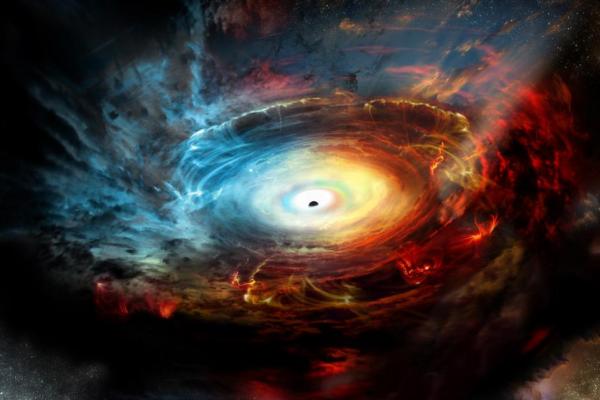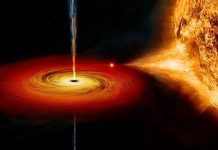
LEWISBURG, Pa., Sept. 15 (UPI) — Even supermassive black holes can be hard to find. Typically, they are hidden by a donut-like ring of gas and dust circling around the center of a galaxy. At least, that’s what astronomers assumed.
Recently, astronomers found a black hole that supplies its own cover. The shroud of debris shielding it from sight is shrapnel ejected from its accretion disk. Its cloak isn’t material being slowly drawn in, but gas and dust being violently thrown back out.
“Think of a black hole as an engine. It’s fueled by material falling in on it from a flattened disk of dust and gas,” Jack Gallimore, an astronomer at Bucknell University,explained in a news release. “But like any engine, a black hole can also emit exhaust.”
The supermassive black hole at the center of the galaxy NGC 1068 is shrouded in its own exhaust.
NGC 1068, sometimes called Messier 77, is a barred spiral galaxy. As its gas and dust spiral toward the galactic center, the material becomes super-heated and emits ultraviolet radiation.
Astronomers used the Atacama Large Millimeter/submillimeter Array, ALMA, to peer beyond this intense radiation. They found cool clouds of carbon monoxide lifting off the edge of the black hole’s accretion disk.
As the clouds are spewed outward, they become excited by the disk’s energy. The centripetal force of the disk causes the excited clouds to snake along the magnetic field lines surrounding the black hole. The process accelerates the clouds to speeds faster than the disk’s rotation, causing the clouds to be flung even farther afield.
“These clouds are traveling so fast that they reach ‘escape velocity’ and are jettisoned in a cone-like spray from both sides of the disk,” Gallimore said. “With ALMA, we can for the first time see that it is the gas that is thrown out that hides the black hole, not the gas falling in.”
Gallimore says the new findings — detailed in the Astrophysical Journal Letters — will force astronomers to rethink the models explaining black holes and their accretion disks. The new observations call into question astronomers’ basic understanding of the movement in and out of a black hole’s accretion disk.
“These are fundamental quantities for understanding black holes that we really don’t have a good handle on at this time,” concluded Gallimore.





